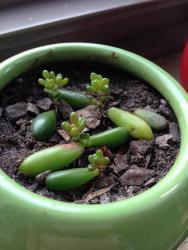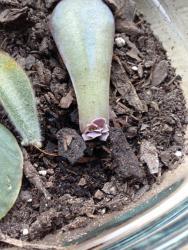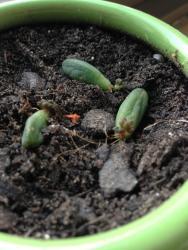As many of you know, I've been trying to propagate my Sedum "Pork and Beans" plant from some of the fallen leaves. Here's an update on those little "pickles on dirt!"
Here they are at approx. 4 weeks old!

Also, I took a leaf from my Echeveria chroma to try and propagate it, and it seems I have another baby plant!

Indoor Cactus Gardening 101
Congratulations! You have entered (or are interested in) the wonderful world of indoor gardening. In this article, we’ll talk specifically about growing Cacti and Succulents indoors. Let’s start by discussing what exactly cacti and succulents are. Succulents are plants that store water in their specialized stems and leaves. Cacti are succulents, too, except they store water only in their specialized stems, and have no leaves. Most succulents and cacti are pretty easy to grow indoors because they thrive on neglect. All you need to do is check on them and give them water about twice a month- and that’s it! These are plants that grow in some of the harshest climates in the world, and are therefore pretty hard to kill. The most common cause of cactus or succulent death is actually over watering! We’ll talk about why later on. But let’s start with some of the basics:
THE PLANTS
Some plants are better suited for indoor life than others, and the same goes for cacti and succulents (C&S). I’ve found that cacti are better suited for indoor life than most succulents are. Here are my top picks for indoor cacti and succulents:
1. Echinopsis subdenudata
This plant, also called the “Domino Cactus” or “Sea Urchin Cactus” is extremely well suited for indoor life. It can tolerate temperatures down to 35 Fahrenheit and do best on filtered light and shade rather than direct light. They stay pretty small, so they’re a good choice for windowsill gardeners. They also flower as houseplants, which is rare among cacti. These guys prefer East or West-facing windows.
2. Crosby’s Prolific Aloe
This plant has been on my windowsill for a while now and absolutely loves it. They can tolerate temperatures down to about 50 Fahrenheit, and need full sun to partial shade, so they’ll do great in a South-facing window (East and West-facing windows work, too). They will bloom indoors if conditions are right. However, they have a tendency to get kind of big, so you may need to cut it back occasionally.
3. Coryphantha retusa These plants also do well indoors. They stay pretty small, and do best with a little bit of direct light with some indirect light. However, these plants won’t flower too well indoors.
4. Moon Cactus (Gymnocalycium cultivar) These are those plants commonly found at Lowe’s or Home Depot have a green base and a brightly colored, spiky top part. This top part is actually another cactus grafted onto the green base. These guys grow well in bright indirect light and stay pretty small. Sometimes these cultivars will flower indoors. However these cacti can’t live forever- the top part has no chlorophyll and cannot survive on its own, so it leeches nutrients from the green part below. After time, the green part will not be able to support the colorful top and the colorful part will die. When this happens, simply chop off the top part with a clean knife and let the green part of the cactus heal, and you will be able to keep the green part for much longer. The base is a Hylocereus cactus, and the top is a Gymnocalycium.
5. Jade Plant (Crassula ovate)
Jade plants are the easiest succulents to grow indoors. They do best in temperatures above 40 Fahrenheit and prefers bright light (it will tolerate indirect light and shade as long as they’re kept drier). These plants are very popular as houseplants, and come in many varieties and colors. They’re resistant to drought, but need more water than the cacti listed above, and will die of underwatering. They’re resistant to bugs, and are super easy to propagate.
Of course, there are more plants than this.
Check out http://windowsillcactus.com/ or the forums here on All Things Plants to get some more information on some of these plants, and others for growth indoors.
BUYING YOUR PLANTS
Buying the plants is an exciting experience. There are, however, several things to look for.
The first thing you want to do is to go to a reputable grower. I recommend calling around to local nurseries to see if they sell C&S. Lowe’s, Home Depot, and Walmart also sell C&S, but some locations take better care of their plants than others do. I usually recommend Lowe’s over both Walmart and Home Depot and Walmart- I have found that their plants are more likely to be diseased.
The second thing to do is to make sure the plant you have your eye on is healthy. Inspect the trunk, the leaves, the spines, and the base of the cactus or succulent to ensure that there are no off-color spots and no squishy areas. If you can, try and dig a little below the dirt line on the base of the plant to check for mushy, brownish spots that could indicate rot. Tap the pot lightly and see if any small gnats fly about. All of these could be signs of disease. Avoid all browning and mushy cacti- they are not healthy. Don’t be afraid to ask one of the shop attendants about the condition of that particular plant.
Thirdly, check the label on the plant. Look at the recommended growing conditions, and make sure you can fulfill the plant’s needs. My apartment does not have south-facing windows, and I cannot give plants direct sun. That means buying a high-light plant is not a great idea for me. Also check the size of the plant- you wouldn’t want a three-foot cactus on your windowsill.
LIGHT
Cacti and succulents (C&S), like all plants, need light in order to grow. Because C&S in particular are native to very hot, dry areas, they need LOTS of light. Place them on a windowsill in your house or apartment with a Southern exposure, if possible. A Western or Eastern exposure will work if you don’t have any other options, but keep in mind that C&S with high light requirements may not thrive. Some people choose to move their indoor C&S outdoors for the summertime to get them more light during the growing season.
That said, some cacti do not need a lot of light, and will scorch or “sunburn” if exposed to too much light. Usually this is not a problem for indoor gardening, as most of the light will be filtered by your window. Be careful if you decide to put your cacti outside for the summer- they will be used to filtered indoor light and have a high probability of scorching. If you do decide to move your plants outdoors, be sure to gradually move them into the light- don’t just stick them in full sun right away.
TEMPERATURE
C&S often grow in hot, arid environments, and need to be kept in temperatures well above freezing. Most cacti can tolerate temperatures no lower than 40 degrees, but this can vary based on the species of plant. This usually is not a problem for houseplants, as most homes are well above 40 degrees Fahrenheit. Make sure your windows don’t have too much of a draft, and always be sure to check what your individual plant needs.
WATER
Water is the number one killer of C&S. These plants are designed to live in places where there is very little rain, so they conserve water within their tissues. Too much water will cause the plants to pull too much water into their tissues, making them burst. This will kill the plant.
Water combined with a warm environment allows for bacteria to grow in the soil. C&S are highly sensitive to bacteria, and easily get infections. “Root rot” is a type of bacteria that grows in water-rich soil that infects the roots, and will usually kill the plant slowly. Hence, it is incredibly important NOT to overwater C&S.
The general rule is to water these plants only when the soil is completely dry. Allowing the soil to completely dry out between waterings prevents bacterial and fungal growth within the soil, and lets the plant use up some of its stored water before you replenish it. This mimics the natural environment of the C&S, where the plants will go weeks before it will rain and water them. Your C&S will need less water in the winter than the summer, so you will see them take longer to go dry in the winter months than in the summer months. I usually water my plants about once a month in the winter, and two to three times per month in the summer.
SOIL
C&S need soil that drains quickly to prevent bacterial and fungal growth in the soil, and to help keep the plant dry. Most commercial C&S soils (i.e. Miracle Grow Cacti and Succulent Mix) work well for indoor plants. However most hobbyists prefer to make their own mix. What I’ve found to work best is a store-bought cactus potting soil mix with some added pearlite or lava rock chunks to help improve drainage. I use 2 parts store-bought mix to 1-part lava rock chunks. Doing a little Googling on the subject of Cactus and Succulent potting mixes will bring up a ton of possible options. Some people use sand, bark, and other things in their mixes, too. But for just getting started, going with a 2:1 ratio of store bought soil to perlite or lava rock chunks works just fine.
POTTING
Potting plants with spikes can be very painful. To prevent getting poked, I will usually put a towel over the top of my plant so I can hold it without getting injured. As far as potting goes, you will want to re-pot your plant once it starts looking too big for its pot (touching the edges, or the pot tipping over) or if the roots start coming out of the bottom of the pot.
For top-heavy C&S like thick aloes or Jade plants, ceramic or terra cotta pots are best because they are heavy enough to keep top-heavy plants from falling over. Plastic pots are useful for plants that are low and globular. I usually buy my pots for windowsill gardening at Walmart or Target. Walmart usually has a good selection of small, cheap ceramic pots small enough to fit on a windowsill, and large enough to hold a pretty good sized plant. Target sells some awesome ~$1 plastic pots that fit nicely on a windowsill. The only rule for buying a pot is that it MUST have good drainage holes. Too little drainage can cause water to build up within the pot and rot out your plant.
As for how to pot a cactus, follow the technique in these videos here:
Part 1: https://www.youtube.com/watch?...
Part 2: https://www.youtube.com/watch?...
PROPAGATION
Most C&S are super easy to propagate. Most of the time, for succulents, fallen leaves left in the pot will simply take root and start growing baby plants. For cacti, they will often sprout “pups”, or baby cacti, off of their sides, which can be separated from the main plant and grown as separate plants. These methods of propagation result in “clones” of the mother plant.
Below is a picture of some Sedum "Pork and Beans" leaves sprouting new plants.
CACTUS DISEASES
No good introduction to C&S is complete without touching on common diseases of C&S. The most common diseases are:
-“Root Rot” This is a catch-all term for bacterial and fungal infections of the soil leading to infection of the roots and rotting of the whole plant from inside out. In most cases, the plant can be caught early in the stages of rot it can be saved by chopping off the rotted portion and allowing the remainder to scab over and grow new roots. However, most cases are not caught early, and the plant will die. Symptoms include yellow to brownish (and in severe cases black) spots that are mushy and oozy on the cactus. Rotted roots will be mushy and will break easy.
-Fungus gnats These guys are more of a nuisance than a plant-threatening problem. They are teeny gnats that lay eggs in moist soil and fly around your plants. They can infect other plants, causing more flies to spawn. The larvae in the soil rarely feed on the plant (they feed on fungi in the soil), so usually these gnats are just annoying and won’t threaten the integrity of the plant. The symptoms are gnats- and lots of them. To get rid of them, let the soil dry out completely between waterings and sprinkle organic cinnamon on the soil to kill fungi the larvae feed on. Cinnamon is a natural antifungal, and will not harm the plant. To control the flies, use commercial gnat traps and swat them at will.
-Scale Scales build up on the surface of the cactus and can appear in many different forms. Look for discolored spots on the cactus that can be scraped off gently with a fingernail- that’s usually scale. If you believe you may have some type of scale, try doing a Google search on what the scale looks like.
-Mealybugs Mealybugs are the bane of cactus and succulent owners. They appear on the cactus as small fuzzy patches with small little bugs (about 1/10’’) near them. Those fuzzy patches are excretions from the bugs. These bugs feed on the plant, and can cause leaves to drop and the plant to eventually yellow and die. If you suspect a mealybug infestation, wash them away with a steady stream of water. Repeat this as many times as necessary for light infestations. You can also use special soaps and insecticides if the infestation is really bad.
LASTLY…
Above all else, research the plant you want before you buy it. The internet has a wealth of information on C&S, and can help you to decide whether you can meet the needs of your individual plant indoors. Not all C&S are suitable for indoor growth, and no two C&S are the same. This guide was intended to be an introduction to indoor C&S gardening. Enjoy learning about your plants and growing them.
Happy Planting!
-Kara
Hooray for the first blog post!
For a long time now, I've let my sedum (pork and beans) just drop its little leaves into the pot when bumped accidentally or what have you. (I bump it a lot. Oops.) And today I noticed that some of those fallen leaves were sprouting baby plants!! I've put them in their own pot now, and have put a picture below.

In other news, I have found some great windowsill cacti. Echniopsis subdenudata (Domino cactus, Fuzzy Navel cactus) thrives indoors on filtered light, which is just perfect for my little windowsill. So does Crosby's Prolific Aloe, which has grown like crazy! My other windowsill plants are all C&S save my peppermint plant, which also loves being indoors.
I've been growing C&S for about a year now, and am currently in college studying engineering. I look forward to graduation and getting my own little gardening space!